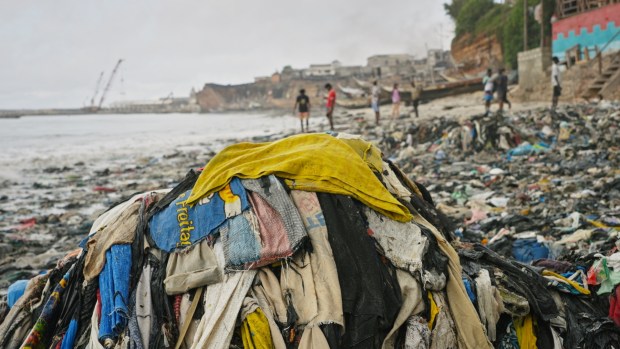Fifteen years ago, the clothing retailer Brandy Melville opened in Los Angeles, and in the decades since it has become the brand for preteen and teenage fashion for girls — specifically thin, white girls. When some customers complained about the tiny one-size-fits-all approach, the company didn’t expand its range of offerings but chose to modify its labels to “one size fits most.”
But according to the documentary “Brandy Hellville & the Cult of Fast Fashion” which premiered on HBO this week (and can be streamed on Max), that was the least of it. The retail stores are allegedly a toxic workplace for its teenage employees and filmmaker Eva Orner talks to them as well as experts about the broader issues with fast fashion, which has increasingly become an environmental problem as unwanted and unusable synthetic clothing piles up.
Lakyn Carlton is a Los Angeles-based virtual stylist and sustainable fashion educator who has long been an informative presence on social media. She offers insights into the clothing industry itself and why it’s worth rethinking the quantity-over-quality mindset when it comes to accumulating a wardrobe. We talked about “Brandy Hellville” and other documentaries worth seeking out if you’re looking to become better informed about the clothing you buy and eventually discard. Our conversation has been edited for clarity and length.
Q: The documentary tries to encompass a lot, not all of it successfully. What did you think of the film?
A: The Brandy Melville parts and the fast fashion parts felt disjointed because they’re not telling you why these are related or what fast fashion even is. I think that’s a problem a lot of fast fashion documentaries fall into, which is an assumption that viewers already have this understanding.
Fast fashion is fast, that is the main identifier of it. It’s not about the price. It’s not even necessarily about the look or how cheap it feels. It is the fact that a brand is making new designs every single week, in some cases every single day. Even if it’s every single month, that’s a lot faster than what it was 10 years ago. It is about having hundreds and thousands of styles and making thousands of units of those styles and selling them to the tune of billions every year.
Q: Why are companies doing this?
A: Because they want you to keep coming back. It’s a constant turnover and people are browsing these sites every single day and they want to have something new for you so that you are more likely to buy. It’s about selling as much as possible, because fashion’s margins are very low for the most part. Even if you’re only making a dollar or $2 per piece, if you’re selling a million of them, that’s good.
But they’re not making new patterns for every piece. They’re not fitting every piece on a human. They’re not making a sample and seeing how it works. They’re not even designing a lot of these things; it’s finding what’s already popular — in the Brandy Melville documentary, they talk about how sometimes it was a piece of clothing one of the retail workers was already wearing — and copying it and making 10,000 of them.
Q: Going back to the ’80s or even earlier, every generation has had brands that teenagers coveted. So this is a consistent phenomenon of seeking validation through clothing. How is Brandy Melville different?
A: It’s the worst kind of natural progression of all that. It’s not just: If you can afford to buy this thing, you’ll be cool. Now it’s: If you can fit into it, you’re cool and beautiful.
It’s wild how strikingly similar a lot of it looks to children’s clothing. They have a lot of those little spaghetti strap tank tops with the little bow in the middle, or little shorts and tiny dresses in these floral prints. They even have shorts that almost look like bloomers.
Q: Oh interesting, the film didn’t really analyze that or the tension of a brand leaning into an infantilizing aesthetic that becomes provocative on teenage bodies. There’s a quote in the film I want to talk about: “You can’t escape the truth, which is that there’s too much clothing.” I don’t know if this idea is accepted in the culture at large.
A: And that is a struggle. You can show people pictures of the Atacama Desert (in Chile), where you can see that pile of clothing from space — which is a mix of unsold clothing or discarded clothing — and it doesn’t really make an impact. One thing I think people don’t realize is that these big piles, especially in a place like Ghana, when they collect rainwater, and can attract bugs and other disease carriers, which is harming people who live near these piles of clothes.
And to people who say we can just recycle these clothes, you can not recycle a pile of clothes that’s big enough to be seen from space. Even if there was enough infrastructure and the desire to do it, we just couldn’t because these companies keep making new stuff! I think 20 years ago, recycling would have been great. It’s not viable anymore just because of the volume of clothing we’re talking about. It’s estimated that we make about 70 billion pieces of clothing a year. We can’t recycle as fast as we dump.
Q: Fast fashion has changed the way people think about why they’re buying clothing.
A: But also social media. I hear so many people say, “I can’t wear the same outfit twice.” And my question is always: Or what? (Laughs) I think as we careen towards even more financial instability, anything that people can cling to that makes them feel like they have some kind of status or wealth or just a little treat in the form of six dresses they’re going to wear once becomes harder to let go of. We have shopping apps on our phones, so some people are shopping because they don’t have anything else to do.
Q: The film covered much of the same ground as 2022’s “White Hot: The Rise & Fall of Abercrombie & Fitch” on Netflix and I was thinking, what do these documentaries add up to? On one hand, it’s good that exposés like this exist. On the other hand, they feel like these piecemeal one-offs that focus on one brand or another and I wonder how useful that is.
A: I agree. So you crossed that one off your list; now what? You just go to the next store and the larger system remains intact. But say you had a movie that breaks down and explains how all these brands are part of the system, then people throw their hands up and say, “Then where do I shop?” And they say forget it, place another order on Amazon and move on.
But I do have some documentaries that I like.
There’s one called “The Machinists” (on YouTube) which follows these three women who work in Dhaka, Bangladesh, and it shows children working in these factories, it shows people getting their wages docked for no reason. I think it does a really good job showing how fashion in general is a human rights issue and a feminist issue. It’s mostly women of color working in those factories, but people don’t have an understanding of what that really means and why they are so ripe for exploitation.
There’s another documentary called “Udita” (on YouTube) which is about a factory in Dhaka as well, where a bunch of well-known brands were producing their clothes. There was so much machinery and weight in the factory that the building collapsed and 1,100 workers died in that. The movie follows a woman who lost two of her daughters in that collapse.
“The True Cost” (on Tubi) also focuses on fast fashion. There’s another film called “River Blue” (on Vimeo) from a conservationist who is evaluating the water in these countries where we produce textiles and clothes and how polluted it is, which is another angle people don’t think about — specifically the water usage and water pollution in fashion doesn’t get talked about nearly enough.
There’s another documentary about the recycling of discarded clothes called “Unravel” (on Vimeo), but unless you understand that this is not the way out, it can lead you down the wrong path. I say watch it, but with the caveat that it’s not going to happen on a wide scale. One thing the film does well is show how the workers who deal with these clothes think about us. They simultaneously admire Western culture but are also kind of disgusted by it.
I think movies that actually talk to the people who make our clothes about how they are forced to work and forced to live, just so we can have new styles every week — and making it clear that it’s not just one brand — is more effective and meaningful.
Q: Maybe what’s missing is programming that helps consumers make different decisions. On social media, I’ve seen you say a version of: “OK, if you want to change how you spend money on clothing, I have some ideas. Hire me, this is what I do.” Because that’s probably a hurdle for people: I’m informed, I feel bad, but I don’t know what to do next. Maybe we need a show like “What Not to Wear” that helps people figure out how to embrace slow fashion concepts. I think sometimes TV and film can open your mind to ideas you can incorporate into your own life.
A: Should I pitch Netflix? (Laughs) But it’s true, just giving information without actionable advice — which is what these documentaries are doing — is at worst frustrating, and at best it can feel like people are scolding you. And nobody likes that.
But I do want people to take it a step further. I think lately my work has pivoted to: How does the slow fashion mindset and being more thoughtful with your purchases benefit you? Well, you know all these grievances you have with your clothes? What if I told you there’s a world where those don’t exist? Because there are brands who care about you having something great and that fits. There’s a world where you love your wardrobe and there’s a world where you don’t feel the need to shop. That’s more the direction we need to be going.
So yeah, I would like to see a documentary or series following someone who makes the journey from having a wardrobe full of fast fashion to adopting a more slow fashion mindset and then building a new wardrobe from there.
Nina Metz is a Tribune critic.




